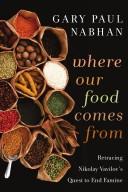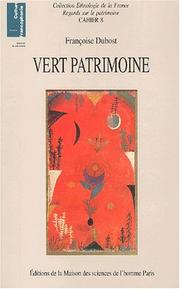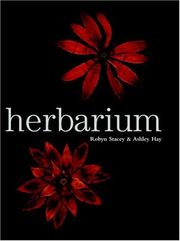| Listing 1 - 6 of 6 |
Sort by
|

ISBN: 1597265179 9781597265171 9781597263993 1597263990 9781610910033 1610910036 Year: 2009 Publisher: Washington [D.C.] : Island Press/Shearwater Books,
Abstract | Keywords | Export | Availability | Bookmark
 Loading...
Loading...Choose an application
- Reference Manager
- EndNote
- RefWorks (Direct export to RefWorks)
The future of our food depends on tiny seeds in orchards and fields the world over. In 1943, one of the first to recognize this fact, the great botanist Nikolay Vavilov, lay dying of starvation in a Soviet prison. But in the years before Stalin jailed him as a scapegoat for the country's famines, Vavilov had traveled over five continents, collecting hundreds of thousands of seeds in an effort to outline the ancient centers of agricultural diversity and guard against widespread hunger. Now, another remarkable scientist-and vivid storyteller-has retraced his footsteps. In Where Our Food Comes Fr
Centers of plant diversity. --- Plant collecting. --- Botanical specimens --- Food crops --- Collection and preservation. --- Germplasm resources --- Vavilov, N. I.
Book
ISBN: 900423411X 9789004234116 9789004234109 9004234101 Year: 2013 Publisher: Leiden ; Boston : Brill,
Abstract | Keywords | Export | Availability | Bookmark
 Loading...
Loading...Choose an application
- Reference Manager
- EndNote
- RefWorks (Direct export to RefWorks)
Nikolaus Joseph Jacquin’s American Plants offers a detailed account of the Austrian botanical expedition to the Caribbean that took place between 1754 and 1759, culminating in the publication of the Selectarum stirpium americanarum historia (1763) by the famous Dutch-born scientist, the first Linnaean botanist in the New World. Novel findings about Jacquin’s family and early life are given. Through a careful reading of Jacquin’s own publications, letters and manuscripts, Santiago Madriñán provides, from a botanist’s perspective, a meticulous description of the places visited by Jacquin and the plants he collected. The splendid color illustrations of the plants published in the luxury second edition of the Selectarum in 1780 are here reprinted, together with an annotated list of the species described. This title was awarded the Stafleu Medal for 2015 for publications of 2013 and 2014 for outstanding publications in historical, bibliographical, and/or nomenclatural aspects of plant taxonomy.
Plant collecting --- Botanical specimens --- Scientific expeditions --- Plants --- Expeditions, Scientific --- Scientific voyages --- Travels --- Voyages, Scientific --- Voyages and travels --- Flora --- Plant kingdom --- Plantae --- Vascular plants --- Vegetable kingdom --- Vegetation --- Wildlife --- Organisms --- Botany --- Botanical collecting --- Plant hunting --- Wild plant collecting --- Collectors and collecting --- Herbarium specimens --- Plant material (Botanical specimens) --- Plant specimens --- Biological specimens --- History --- Collection and preservation --- Jacquin, Nikolaus Joseph, --- Jacquin, Nicolaas Jozeph, --- Travel
Book
ISBN: 9781623495442 162349544X 9781623495459 1623495458 Year: 2017 Publisher: College Station, [Texas] : Texas A&M University Press,
Abstract | Keywords | Export | Availability | Bookmark
 Loading...
Loading...Choose an application
- Reference Manager
- EndNote
- RefWorks (Direct export to RefWorks)
"In The Rose Rustlers, Greg Grant and William C. Welch offer a personal, in-depth, and entertaining account of some of the great stories gathered during their years as participants in one of the most important plant hunting efforts of the twentieth century--the quest to save antique roses that disappeared from the market in a notoriously trend-driven business. By the 1950s, almost exclusively, modern roses (those with one compact bloom at the top of a large stem) were grown for the cut-flower market. The large rounded shrubs and billowy fence climbers known to our grandparents and great grandparents in the nineteenth and early twentieth centuries had been reduced to this rather monotonous single style of plant. Yet those roses of old still grew, tough and persistent, in farmyards, cemeteries, vacant lots, and abandoned fields. The rediscovery of these antiques and the subsequent movement to conserve them became the mission of "rose rustlers," dedicated rosarians who studied, sought, cut, and cultivated these hardy survivors. Here, the authors attempt to chronicle their own origins, adventures, and discoveries as part of a group dubbed the Texas Rose Rustlers. They present tales of the many efforts that have helped restore lost roses not only to residential gardens, but also to commercial and church landscapes in Texas. Their experiences and friendships with other figures in the heirloom rose world bring an insider's perspective to the lore of "rustling," the art of propagation, and the continued fascination with the world's favorite flower."--
Old roses --- Rose culture --- Plant collecting --- Botanical collecting --- Plant hunting --- Wild plant collecting --- Collectors and collecting --- Botanical specimens --- Rose growing --- Floriculture --- Old-fashioned roses --- Old garden roses --- Old shrub roses --- Roses --- Propagation --- Collection and preservation --- Texas Rose Rustlers --- Brazos Symposium --- History.

ISBN: 273510608X 2735115860 Year: 1994 Volume: 8 Publisher: Paris : Editions de la Maison des Sciences de l'Homme,
Abstract | Keywords | Export | Availability | Bookmark
 Loading...
Loading...Choose an application
- Reference Manager
- EndNote
- RefWorks (Direct export to RefWorks)
Jardins et plantes cultivées, fruits et légumes ou végétaux d'ornement, sont entrés depuis peu dans le domaine du patrimoine. La sauvegarde des espèces en voie de disparition, la redécouverte et la restauration des jardins historiques, ont en quelques années mobilisé responsables publics et militants associatifs, amateurs et professionnels, spécialistes et gens ordinaires. Dans le succès des expositions-ventes de plantes rares, la floraison des collections inédites, le vigoureux combat des associations pour la préservation des variétés locales ou la renaissance de l'art des jardins, l'auteur décèle bien plus qu'un phénomène de mode, l'éclosion de formes nouvelles de sensibilité à la nature et au passé. Le patrimoine végétal, parce qu'il est vivant et impossible à muséifier, met à l'épreuve les procédures et les modes de gestion traditionnels, oblige à tenir compte des dimensions du temps et de l'usage, et donc à penser en termes nouveaux la question du patrimoine.
Germplasm resources, Plant --- Horticultural crops --- Plant collecting --- Plantes --- Cultures horticoles --- Germplasm resources --- Ressources génétiques --- Collectionneurs et collections --- Ressources génétiques --- Botanical collecting --- Plant hunting --- Wild plant collecting --- Collectors and collecting --- Botanical specimens --- Crops, Horticultural --- Horticulture --- Plants, Cultivated --- Food crops --- Tree crops --- Conservation of plant genetic resources --- Conservation of plant germplasm resources --- Plant genetic resources --- Plant germplasm resources --- Collection and preservation --- jardin --- jardin populaire --- art des jardins --- patrimoine --- botanique --- sociologie des arts --- paysage --- FRANCE --- PLANTES RARES --- SELYS LONGCHAMPS (FAMILLE) --- AGRICULTURE --- HISTOIRE --- HORTICULTURE
Book
ISBN: 9783658086961 3658086955 9783658086954 3658086963 Year: 2015 Publisher: Wiesbaden : Springer Fachmedien Wiesbaden : Imprint: Springer Spektrum,
Abstract | Keywords | Export | Availability | Bookmark
 Loading...
Loading...Choose an application
- Reference Manager
- EndNote
- RefWorks (Direct export to RefWorks)
This study focuses on understanding the socio-economic relevance of plant resources collected from the wild and its relation to current patterns of trade and sustainability. Grischa Brokamp reviews and analyzes the current extent of palm trade in northwestern South America, its impact, limitations and future perspective. Indeed there are conflicts between the commercialization of wild plant resources and the conservation of exploited species, which is illustrated by examples from the plant families Arecaceae and Krameriaceae Contents Standardized Data Collection on Trade in Palm Products Trade in Palm Products in North-Western South America Case study on Productivity and Management of Phytelephas aequatorialis (Arecaceae) in Ecuador Parasitism and Haustorium Anatomy of Krameria lappacea (Krameriaceae), an Endangered Medicinal Plant from the Andean Deserts Abundance, Seed Ecology, and Regeneration of Krameria lappacea from the Peruvian Andes Target Groups Researchers and students in the fields of natural resource management and conservation biology Government officials, NGO representatives and practitioners in these areas The Author Dr. Grischa Brokamp contributed to the EU-FP7-PALMS project and acquired his doctorate at Freie Universität Berlin.
Life Sciences. --- Plant Sciences. --- Agriculture. --- Sustainable Development. --- Life sciences. --- Botany. --- Sustainable development. --- Sciences de la vie --- Agriculture --- Botanique --- Développement durable --- Botany --- Earth & Environmental Sciences --- Botany - General --- Plant collecting --- Botanical collecting --- Plant hunting --- Wild plant collecting --- Plant science. --- Collectors and collecting --- Botanical specimens --- Collection and preservation --- Development, Sustainable --- Ecologically sustainable development --- Economic development, Sustainable --- Economic sustainability --- ESD (Ecologically sustainable development) --- Smart growth --- Sustainable development --- Sustainable economic development --- Economic development --- Farming --- Husbandry --- Industrial arts --- Life sciences --- Food supply --- Land use, Rural --- Botanical science --- Phytobiology --- Phytography --- Phytology --- Plant biology --- Plant science --- Biology --- Natural history --- Plants --- Environmental aspects --- Floristic botany

ISBN: 0521842778 0511082320 9780511082320 1280415924 9781280415920 9780511196249 0511196245 0521603927 9780521842778 1107140471 9786610415922 0511170742 0511297912 0511481543 0511081871 9780511481543 Year: 2004 Publisher: Cambridge, U.K. ; New York, N.Y. : Cambridge University Press,
Abstract | Keywords | Export | Availability | Bookmark
 Loading...
Loading...Choose an application
- Reference Manager
- EndNote
- RefWorks (Direct export to RefWorks)
This stunning book of photographs by Robyn Stacey, one of Australia's greatest photographers, is the first of its kind. Together with essayist, Ashley Hay, they throw open the closed doors of the Royal Botanic Gardens, Sydney herbarium, and reveal the secret history of Australia's flora. Herbarium tells fascinating stories about the nature of collecting, those who collected, what they collected and when, and the scientific background to each of the specimens. A glossary of botanical descriptions provides a unique link between the specimens and their collectors, and exquisite photographs of the botanical specimens - some now extinct - comprise a collection of rare beauty.
BOT General Botany --- general botany --- herbarium collections --- history of botany --- plants and arts --- Botany --- Plant collecting --- Plant collectors --- Botanical specimens --- Herbarium specimens --- Plant material (Botanical specimens) --- Plant specimens --- Biological specimens --- Botanical collectors --- Plant hunters --- Botanists --- Collectors and collecting --- Naturalists --- Botanical collecting --- Plant hunting --- Wild plant collecting --- Botanical science --- Floristic botany --- Phytobiology --- Phytography --- Phytology --- Plant biology --- Plant science --- Biology --- Natural history --- Plants --- History. --- Collection and preservation --- National Herbarium of New South Wales. --- New South Wales. --- New South Wales National Herbarium --- Arts and Humanities --- General and Others
| Listing 1 - 6 of 6 |
Sort by
|

 Search
Search Feedback
Feedback About UniCat
About UniCat  Help
Help News
News